
Nivomat Shock Conversion
Volvo 760/780/960 Nivomat Shock Conversion PDF
![]() This FAQ file outlines two procedures: conversion of the IRS Nivomat setup on some 700 series cars by 2Lt Jonathon Belmont, USA, and conversion of the same setup on a 960 car by Bruce Kessler.
This FAQ file outlines two procedures: conversion of the IRS Nivomat setup on some 700 series cars by 2Lt Jonathon Belmont, USA, and conversion of the same setup on a 960 car by Bruce Kessler.
760 Nivomat Conversion. This step-by-step guide was written and photographed by 2LT Jonathon Belmont, USA. Conversion of the Independent Rear Suspension found on some 700 and 900 series cars from a Nivomat (self-levelling) setup to a conventional shock and spring setup is neither overly difficult or prohibitively expensive. IF you have the right tools, time, and know-how. This step-by-step guide will cover required materials, parts, labor, procedure, and expected results.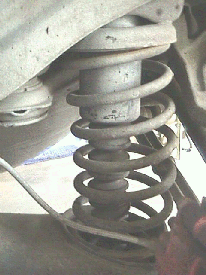
Tools. You will need a lift that will support the vehicle by the chassis, not by the tires. You will need at least one coil spring compressor, the type that goes inside the spring and has two sets of flexible jaws... two is highly recommended. Air tools will be a big help as well, as it can get mundane and difficult to compress the springs by hand. Also in the air tool department, a cut-off tool to cut the pigtail off the rear springs (get to that later). You'll also need a socket wrench set to remove a few bolts securing the brake caliper (to move it out of the way so you don't rupture a brake line... learned that the hard way) and the bolts that secure the shock. You'll also need a block of wood that will keep the trailing arm extended while you compress the spring. A large pry bar may also come in handy.
The notes below include two different procedures: wedging the spring out with the trailing arm in place, or unbolting it instead. The latter is much easier. However, unbolting would have been difficult if not impossible had I not had access to the auto shop on base, complete w/ air tools, press, cutoff wheel, grinder, lift, and hydraulic tranny stand. If you have none of these, then you will need to compress the spring and wedge it out.
Shocks and Springs. As for the parts themselves, I got two Bilstein B46-1662 shocks.![]() I got them for about $120 for the pair (I think) from shox.com. I also got IPD overload coils for a 200-series... wagon preferred, because you will then need no spring spacers. When you cut the pigtail off the springs, they're a good fit. I cut it off right where it started to resume normal circumfrence, it was exactly one turn. Finally, you'll need something to spread the rear springs about an inch or so... I got the kind that twist into the coils (two on each side) from auto zone... any discount auto chain should sell something similar. If you use the sedan springs, the only difference in the back between lowering and just converting is the size of the spacers you must put in the rear springs when you're done. If you use about 1" spacers and cut the front springs like I did, the car will ride level at about 1 to 1.5" lower than stock. If you don't cut the front coils, you'll need to spread the rear springs at least 2"... I wouldn't try it; get some springs custom made instead.
I got them for about $120 for the pair (I think) from shox.com. I also got IPD overload coils for a 200-series... wagon preferred, because you will then need no spring spacers. When you cut the pigtail off the springs, they're a good fit. I cut it off right where it started to resume normal circumfrence, it was exactly one turn. Finally, you'll need something to spread the rear springs about an inch or so... I got the kind that twist into the coils (two on each side) from auto zone... any discount auto chain should sell something similar. If you use the sedan springs, the only difference in the back between lowering and just converting is the size of the spacers you must put in the rear springs when you're done. If you use about 1" spacers and cut the front springs like I did, the car will ride level at about 1 to 1.5" lower than stock. If you don't cut the front coils, you'll need to spread the rear springs at least 2"... I wouldn't try it; get some springs custom made instead.
Lower Mount. The lower mount must be either fabricated or cannibalized from the old nivomat. I went with the fabricated route last time (see below for illustrations), and tried the cannibalization route the next time. Why? Because I spent about 4 hours trying to make my own mounts, only to discover when I went to install them that I had drilled the holes slightly off and a bit too far out, and they were too long in general and therefore wouldn't fit. Rather than leave the car in the shop, I took the old Nivos and proceeded to press out the metal center of the bushing. Naturally, the rubber was destroyed, so I just saved the center metal portion. Now here's the trick: the Bilstein already has a metal sleeve just the right size OUTER diameter in the middle of its rubber bushing. The metal sleeve is VERY firmly fixed to the rubber bushing. Fortunately, the rubber bushing is NOT very firmly fixed to the rest of the shock, and therefore can be pressed out without totally destroying it. At this point, I was running short of time, so I cut the bushing down one of the seams and used liquid wrench and a screwdriver to separate the rubber bushing from the metal sleeve. I then pressed the bushing back into the shock and the center metal portion from the nivomat back into the bushing. Seems to work fine. Next time, I'll look for a comparable bushing ahead of time, so I don't have to worry about saving the one I extricate from the bilstein.
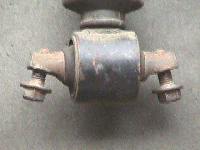 If you fabricate your change to the lower shock mount... a machine shop should be able to do this for minimal cost, or if you have access to the right tools, it shouldn't prove too difficult to fabricate. It's simply a piece of steel tubing that's passed through the lower mount, crimped
If you fabricate your change to the lower shock mount... a machine shop should be able to do this for minimal cost, or if you have access to the right tools, it shouldn't prove too difficult to fabricate. It's simply a piece of steel tubing that's passed through the lower mount, crimped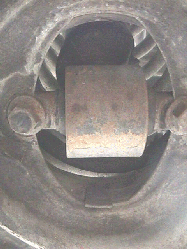 together, drilled, and then slightly bent upwards. Once you get the parts and have a close look at the old lower mount on the Nivomat, this cryptic description will become much clearer.
together, drilled, and then slightly bent upwards. Once you get the parts and have a close look at the old lower mount on the Nivomat, this cryptic description will become much clearer.
Procedure: Removal. The procedure should take a full afternoon... probably 8-10 hours. I started in the front and worked my way back, because I wanted the car lowered about an inch and not just converted to a conventional setup. I removed the front springs and cut off about a coil and a half... this lowered the car about an inch and a quarter, and made the suspension a bit stiffer. I'm sure 700 series lowering springs would also do the job but I'm cheap and cutting the coils worked just fine.
You've got to remove the Nivomat shock first, then put in the wood block to keep the trailing arm fully extended. I think I stuck the one I found between the top of the fender well and something else off to the side, I really don't remember. Just make sure that it is sturdy (I used a 4" by 4") because when you compress the spring and remove it, the trailing arm is going to want to retract, seriously limiting your room to work. If you do not have a jack to raise and lower the trailing arm, then remove the brake caliper so it's not in the way, and so you don't bust a brake line by mistake.
Three bolts secure the nivomat- one up top and two through the bottom of the trailing arm. Remove them. Three bolts and a nut secure the mounting point of the trailing arm (towards the front of the car) to the frame. [If you have a lift and are using a jack to support the trailing arm: I chose to remove them, because the way I had the car jacked up didn't allow easy access to the one bolt which went through the trailing arm bushings and secured to the mounting point. I had the car up on a lift when I did this, and used an adjustable hydraulic tranny stand to support the trailing arm as I undid the bolts & nut, then I lowered the tranny stand and the trailing arm to remove the old spring and drop in the new one.]
If you don't have it on a lift, then compress the spring and get it out of the top spring seat so that you can pull it towards the fender well opening and out to freedom (this is the tough, time consuming, and quite frankly DANGEROUS part). I put two spring compressors up inside the spring with one end of each one clipped as high up on the coils as they could reach, and the other ends dangling loose below the trailing arm. Then, I placed two sturdy wrenches across the hooks that were hanging below the trailing arm... that way, when I began to compress the spring compressors, the wrenches prevented the bottom end of the spring compressor from retreating back up into the trailing arm hole. When they stopped at the bottom of the trailing arm, the compressors began to pull the top of the spring down towards the bottom of the spring, gradually unseating it from the top spring seat. Unfortunately, as I compressed the spring compressors, the long bolts will ran up into the hole for the shock, preventing me from tilting the whole damn thing over to the side and freeing the spring. This is why it's nice to have TWO spring compressors... Once the spring was fully compressed by both compressors, I let up on the outboard one (closest to the wheel well), pulled the spring towards me so that part of it was outside the spring seat, and then reinstalled the one I loosened with its bolt on the outside of the shock hole this time. This allowed me to compress it enough to get it more than halfway out of the shock hole at the top... then I released the spring compressor that was still sticking its long bolt up into the hole, and I pried like hell to get the whole spring out.
Procedure: Installation. Installation is the reverse of disassembly. Get the spring back in, then put in the shock. Next, put in whatever spring spacers you decided to use.[Note: not needed if you used the IPD wagon overload springs] .. that'll keep the car from riding on the bump stop. Don't install the spring spreaders before you put the shock back in, because you need to be able to see where the spring's maximum clearance is. Depending on what type of spreader you get, you may hear an occasional thump as the spreader whacks up against the shock tube going over a bump or around a corner.
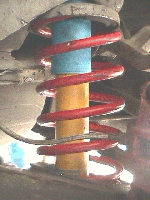
[If you are using a lift and a tranny jack: Jack the trailing arm back up and hope that the bolt holes line up and you can get a few in. I ended up getting one or two started, but the big nut in the center wouldn't go, so I jacked the stand up a bunch more to lift that corner of the car off of it's lift support (VERY CAREFULLY), then moved the lift support from the jack point to underneath the trailing arm itself. Then, I lowered the tranny stand. This way, rather than the tranny stand pushing up on the trailing arm, I had the weight of the whole car pushing down on it. This provided a bit more compression and allowed me to get all bolts and the nut started sufficiently that I could crank them down securely. Now put in the new shock and you're all done! I previously suggested removing the caliper so it wasn't in the way, and as it turns out, dropping the trailing arm makes removing the spring so easy that the caliper removal step 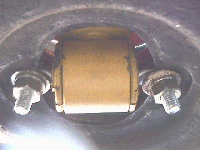 can be eliminated.]
can be eliminated.]
All in all, my car is about an inch and a half lower, and once I got it aligned, it was extended to the maximum camber capacity (if you find a way to overcome this, let me know) and the tires still squat a little. Ride is noticeably improved and so is handling and even gas mileage a bit. The car loves tocorner, and dampens out small and large bumps with little complaining. It doesn't roll as much in the corners and traction is better. This may seem like a daunting task, but I'd take it on again in a heartbeat... well worth it!!!
960 Nivomat Conversion [Bruce Kessler]. My Nivomats were blown out on my 960 with IRS and I did not want to spend $600+ to replace them, so I fixed the problem by installing coil springs and shocks from a 1992 Toyota Previa. I got the springs from a salvage yard and the shocks from RockAuto.com. The shocks are Monroe Part #31162. The length and travel of these shocks closely matches that of the Nivomats. I also chose the Previa shocks since they are designed to dampen at the Previa spring rate. The difference in spring rates is drastic: the 960 spring rate is about 75 pounds per inch and the Previa spring rate is 260 pound per inch.
To use the Previa shocks, I had to install the upper bushings from the Nivomats into the top mount and made lower mount plates for the bottom. The bottom mount plates are about 3/16 inch thick and 1 inch wide, drilled to bolt up to the two original Nivomat mount holes; a third hole is drilled in the middle of the plate for mounting the shock stem.
I wanted to maintain the original ride height, and what I've read said that the Previa springs will lower the car by 1 ½ inches. Therefore, I installed one Mr. Gasket 1 ½ inch rubber coil spring lift spacer (available at most auto parts stores) under each Previa spring. With this set up the car rides at original hight.
With the Previa springs and shocks the ride is awesome. Although the self leveling feature is lost, the ride is smoother than ever and traction is greatly improved. I feel that the much improved ride out weighs the loss of the self leveling. The rear used to slip out easily when cornering with the worn Nivomats, now I have to work hard to get it to slip. I also have not hit the stops since installing the new springs and shocks, even while pulling my 3,000 pound boat.
In all the Previa spring/shock conversion cost me about $110 and a couple days work.
Information on the springs: MOOG Part # CC251, Inside Diameter: 3.838", Bar Diameter: 0.593", Install Height: 11.00", Load: 456lbs , Spring Rate: 260 lbs/in, Free Height: 12.70". Information on the Nivomats: 1 994 Volvo 960 Rear Nivomat Shock 18.375” extended length; 11.875” compressed length
Information on the Previa shocks: 19.375” extended length; 11.875” compressed length